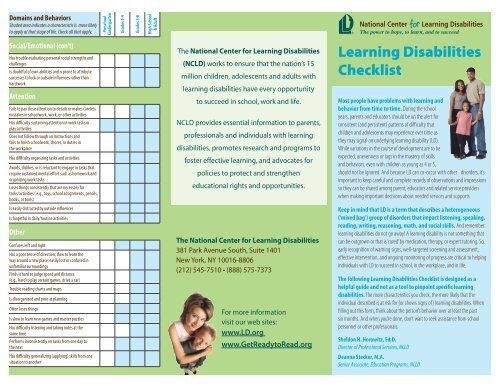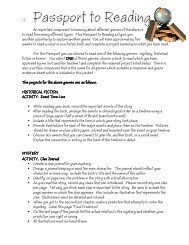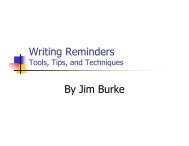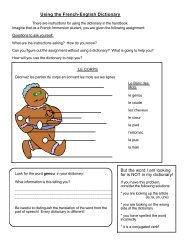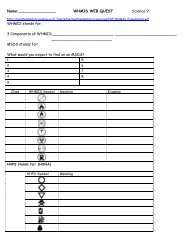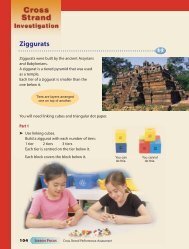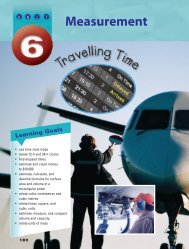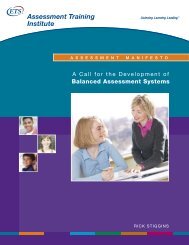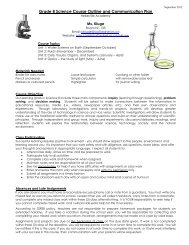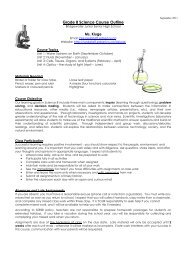Learning Disabilities Checklist - Learning Disabilities Association of ...
Learning Disabilities Checklist - Learning Disabilities Association of ...
Learning Disabilities Checklist - Learning Disabilities Association of ...
You also want an ePaper? Increase the reach of your titles
YUMPU automatically turns print PDFs into web optimized ePapers that Google loves.
Domains and Behaviors<br />
Shaded area indicates a characteristic is more likely<br />
to apply at that stage <strong>of</strong> life. Check all that apply.<br />
Social/Emotional (con’t)<br />
Has trouble evaluating personal social strengths and<br />
challenges<br />
Is doubtful <strong>of</strong> own abilities and is prone to attribute<br />
successes to luck or outside influences rather than<br />
hard work<br />
Attention<br />
Fails to pay close attention to details or makes careless<br />
mistakes in schoolwork, work, or other activities<br />
Has difficulty sustaining attention in work tasks or<br />
play activities<br />
Does not follow through on instructions and<br />
fails to finish schoolwork, chores, or duties in<br />
the workplace<br />
Has difficulty organizing tasks and activities<br />
Avoids, dislikes, or is reluctant to engage in tasks that<br />
require sustained mental effort such as homework and<br />
organizing work tasks<br />
Loses things consistently that are necessary for<br />
tasks/activities ( e.g., toys, school assignments, pencils,<br />
books, or tools)<br />
Is easily distracted by outside influences<br />
Is forgetful in daily/routine activities<br />
Other<br />
Confuses left and right<br />
Has a poor sense <strong>of</strong> direction; slow to learn the<br />
way around a new place; easily lost or confused in<br />
unfamiliar surroundings<br />
Finds it hard to judge speed and distance<br />
(e.g., hard to play certain games, drive a car)<br />
Trouble reading charts and maps<br />
Is disorganized and poor at planning<br />
Often loses things<br />
Is slow to learn new games and master puzzles<br />
Has difficulty listening and taking notes at the<br />
same time<br />
Performs inconsistently on tasks from one day to<br />
the next<br />
Has difficulty generalizing (applying) skills from one<br />
situation to another<br />
The National Center for <strong>Learning</strong> <strong>Disabilities</strong><br />
(NCLD) works to ensure that the nation’s 15<br />
million children, adolescents and adults with<br />
learning disabilities have every opportunity<br />
to succeed in school, work and life.<br />
NCLD provides essential information to parents,<br />
pr<strong>of</strong>essionals and individuals with learning<br />
disabilities, promotes research and programs to<br />
foster effective learning, and advocates for<br />
policies to protect and strengthen<br />
educational rights and opportunities.<br />
The National Center for <strong>Learning</strong> <strong>Disabilities</strong><br />
381 Park Avenue South, Suite 1401<br />
New York, NY 10016-8806<br />
(212) 545-7510 • (888) 575-7373<br />
For more information<br />
visit our web sites:<br />
www.LD.org<br />
www.GetReadytoRead.org<br />
<strong>Learning</strong> <strong>Disabilities</strong><br />
<strong>Checklist</strong><br />
Most people have problems with learning and<br />
behavior from time to time. During the school<br />
years, parents and educators should be on the alert for<br />
consistent (and persistent) patterns <strong>of</strong> difficulty that<br />
children and adolescents may experience over time as<br />
they may signal an underlying learning disability (LD).<br />
While variations in the course <strong>of</strong> development are to be<br />
expected, unevenness or lags in the mastery <strong>of</strong> skills<br />
and behaviors, even with children as young as 4 or 5,<br />
should not be ignored. And because LD can co-occur with other disorders, it’s<br />
important to keep careful and complete records <strong>of</strong> observations and impressions<br />
so they can be shared among parent, educators and related service providers<br />
when making important decisions about needed services and supports.<br />
Keep in mind that LD is a term that describes a heterogeneous<br />
(‘mixed bag’) group <strong>of</strong> disorders that impact listening, speaking,<br />
reading, writing, reasoning, math, and social skills. And remember:<br />
learning disabilities do not go away! A learning disability is not something that<br />
can be outgrown or that is ‘cured’ by medication, therapy, or expert tutoring. So,<br />
early recognition <strong>of</strong> warning signs, well-targeted screening and assessment,<br />
effective intervention, and ongoing monitoring <strong>of</strong> progress are critical to helping<br />
individuals with LD to succeed in school, in the workplace, and in life.<br />
The following <strong>Learning</strong> <strong>Disabilities</strong> <strong>Checklist</strong> is designed as a<br />
helpful guide and not as a tool to pinpoint specific learning<br />
disabilities. The more characteristics you check, the more likely that the<br />
individual described is at risk for (or shows signs <strong>of</strong>) learning disabilities. When<br />
filling out this form, think about the person’s behavior over at least the past<br />
six months. And when you’re done, don’t wait to seek assistance from school<br />
personnel or other pr<strong>of</strong>essionals.<br />
Sheldon H. Horowitz, Ed.D.<br />
Director <strong>of</strong> Pr<strong>of</strong>essional Services, NCLD<br />
Deanna Stecker, M.A.<br />
Senior Associate, Education Programs, NCLD
<strong>Learning</strong> <strong>Disabilities</strong> <strong>Checklist</strong><br />
Domains and Behaviors<br />
Shaded area indicates a characteristic is more likely<br />
to apply at that stage <strong>of</strong> life. Check all that apply.<br />
Gross and Fine Motor Skills<br />
Appears awkward and clumsy, dropping, spilling, or<br />
knocking things over<br />
Has limited success with games and activities that<br />
demand eye-hand coordination (e.g., piano lessons,<br />
basketball, baseball)<br />
Has trouble with buttons, hooks, snaps, zippers and<br />
trouble learning to tie shoes<br />
Creates art work that is immature for age<br />
Demonstrates poor ability to color or write ‘within<br />
the lines’<br />
Grasps pencil awkwardly, resulting in poor handwriting<br />
Experiences difficulty using small objects or items that<br />
demand precision (e.g., Legos, puzzle pieces, tweezers,<br />
scissors)<br />
Dislikes and avoids writing and drawing tasks<br />
Language<br />
Demonstrates early delays in learning to speak<br />
Has difficulty modulating voice (e.g., too s<strong>of</strong>t, too loud)<br />
Has trouble naming people or objects<br />
Has difficulty staying on topic<br />
Inserts invented words into conversation<br />
Has difficulty re-telling what has just been said<br />
Uses vague, imprecise language and has a limited<br />
vocabulary<br />
Demonstrates slow and halting speech, using lots <strong>of</strong><br />
fillers (e.g., uh, um, and, you know, so)<br />
Uses poor grammar or misuses words in conversation<br />
Mispronounces words frequently<br />
Confuses words with others that sound similar<br />
Inserts malapropisms (‘slips <strong>of</strong> the tongue’) into<br />
conversation (e.g., a rolling stone gathers no moths;<br />
he was a man <strong>of</strong> great statue)<br />
Has difficulty rhyming<br />
Has limited interest in books or stories<br />
Has difficulty understanding instructions or directions<br />
Has trouble understanding idioms, proverbs,<br />
colloquialisms, humor, and/or puns<br />
(note: take into account regional and cultural factors)<br />
Domains and Behaviors<br />
Shaded area indicates a characteristic is more likely<br />
to apply at that stage <strong>of</strong> life. Check all that apply.<br />
Language (con’t)<br />
Has difficulty with pragmatic skills (e.g., understands<br />
the relationship between speaker and listener, stays on<br />
topic, gauges the listeners degree <strong>of</strong> knowledge, makes<br />
inferences based on a speaker’s verbal and non-verbal cues)<br />
Reading<br />
Confuses similar-looking letters and numbers<br />
Has difficulty recognizing and remembering<br />
sight words<br />
Frequently loses place while reading<br />
Confuses similar-looking words (e.g., beard/bread)<br />
Reverses letter order in words (e.g., saw/was)<br />
Demonstrates poor memory for printed words<br />
Has weak comprehension <strong>of</strong> ideas and themes<br />
Has significant trouble learning to read<br />
Has trouble naming letters<br />
Has problems associating letter and sounds,<br />
understanding the difference between sounds in words<br />
or blending sounds into words<br />
Guesses at unfamiliar words rather than using word<br />
analysis skills<br />
Reads slowly<br />
Substitutes or leaves out words while reading<br />
Has poor retention <strong>of</strong> new vocabulary<br />
Dislikes and avoids reading or reads reluctantly<br />
Written Language<br />
Dislikes and avoids writing and copying<br />
Demonstrates delays in learning to copy and write<br />
Writing is messy and incomplete, with many cross outs<br />
and erasures<br />
Has difficulty remembering shapes <strong>of</strong> letters and<br />
numerals<br />
Frequently reverses letters, numbers and symbols<br />
Uses uneven spacing between letters and words, and<br />
has trouble staying ‘on the line’<br />
Copies inaccurately (e.g., confuses similar-looking<br />
letters and numbers)<br />
Spells poorly and inconsistently (e.g., the same word<br />
appears differently other places in the same document)<br />
Domains and Behaviors<br />
Shaded area indicates a characteristic is more likely<br />
to apply at that stage <strong>of</strong> life. Check all that apply.<br />
Written Language (con’t)<br />
Has difficulty pro<strong>of</strong>reading and self-correcting work<br />
Has difficulty preparing outlines and organizing<br />
written assignments<br />
Fails to develop ideas in writing so written work is<br />
incomplete and too brief<br />
Expresses written ideas in a disorganized way<br />
Math<br />
Has difficulty with simple counting and one-to-one<br />
correspondence between number symbols and items/<br />
objects<br />
Difficulty mastering number knowledge<br />
(e.g. recognition <strong>of</strong> quantities without counting)<br />
Has difficulty with learning and memorizing basic<br />
addition and subtraction facts<br />
Has difficulty learning strategic counting principles<br />
(e.g. by 2, 5, 10, 100)<br />
Poorly aligns numbers resulting in computation errors<br />
Has difficulty estimating (e.g., quantity, value)<br />
Has difficulty with comparisons (e.g., less than, greater than)<br />
Has trouble telling time<br />
Has trouble conceptualizing the passage <strong>of</strong> time<br />
Has difficulty counting rapidly or making calculations<br />
Has trouble learning multiplication tables, formulas<br />
and rules<br />
Has trouble interpreting graphs and charts<br />
Social/Emotional<br />
Does not pick up on other people’s mood/feelings<br />
(e.g., may say the wrong thing at the wrong time)<br />
May not detect or respond appropriately to teasing<br />
Has difficulty ‘joining in’ and maintaining positive<br />
social status in a peer group<br />
Has trouble knowing how to share/express feelings<br />
Has trouble ‘getting to the point’<br />
(e.g., gets bogged down in details in conversation)<br />
Has difficulty with self-control when frustrated<br />
Has difficulty dealing with group pressure,<br />
embarrassment and unexpected challenges<br />
Has trouble setting realistic social goals<br />
© 2007 by National Center for <strong>Learning</strong> <strong>Disabilities</strong>, Inc. Permission is granted to reprint material for noncommercial purposes. Citation <strong>of</strong> NCLD as a source is required.


